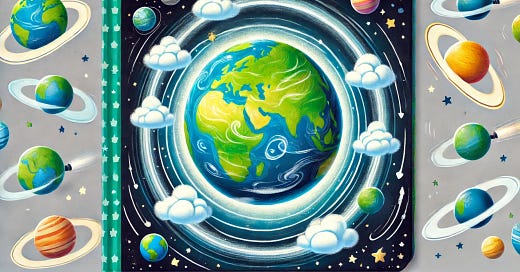Why is the Earth Round?
Have you ever looked at pictures of Earth from space? It looks like a big, blue ball floating in the black sky! But have you ever wondered why the Earth is round and not square or shaped like a triangle? Let’s take a journey together to discover why our amazing planet is shaped the way it is.
Hello my friends!
For a quick note, welcome to Tidbits with Titus, a podcast and newsletter where we tackle the big, curious questions kids ask every day in fun, bite-sized ways! I’m Alexander Titus, but I go by Titus. I’m a scientist, adventurer, and a huge fan of making science, technology, and life accessible to all ages. From “How does electricity work?” to “What are taxes?” and even “Why is the sky blue?” I’m here to dive into these wonder-filled questions with engaging stories and simple explanations that spark curiosity and make learning a joy. This effort is all about creating a space where families can learn together, discover the magic of the every day, and find thoughtful ways to explore the world’s big mysteries. Let’s make curiosity a family tradition—one tidbit at a time!
Just so you know, these podcast episodes are all AI-generated using Google’s really cool NotebookLM technology. That means there are some errors in how words are said, but that is part of the fun!
If your little ones have questions that you want help answering, shoot me an email at questions@tidbitswithtitus.com and I’ll see what I can do!
You can subscribe to the newsletter that has this information as well at tidbitswithtitus.com.
Also please share with anyone you think would be interested. The more the merrier!
Cheers,
-Titus
What Does "Round" Mean?
First, let’s talk about what it means to be “round.” When we say the Earth is round, we don’t mean it’s a perfect ball, like a marble or a basketball. Earth is actually shaped like a sphere, but it’s a little squished at the top and bottom. Scientists call this shape an oblate spheroid. This means it’s slightly wider in the middle (the equator) and flatter near the North and South Poles.
Gravity: The Earth-Shaping Superpower
The main reason Earth is round is because of gravity. Gravity is a special force that pulls things toward the center of an object, like a planet. Imagine you’re holding a handful of sand. If you drop the sand into a pile, gravity pulls the sand down to make a rounded mound. Now think about Earth when it was first forming. It wasn’t solid like it is now. It was a big, hot, squishy ball of rocks and gas!
Back then, gravity worked to pull all the material together evenly. Since gravity pulls from all directions toward the center, it made Earth into a sphere. This shape is the most balanced and stable shape that gravity can create.
Why Not a Square Earth?
You might think a square Earth would be fun. But it wouldn’t work! Imagine trying to form a cube with something soft, like dough. The corners wouldn’t stay sharp because gravity would pull everything toward the middle. Over time, the dough would become round, just like Earth did!
Spinning Makes a Difference
Earth doesn’t just sit still in space—it spins! This spinning is called rotation, and it happens very fast. The Earth completes one full spin every 24 hours, which gives us day and night. This spinning causes something called centrifugal force. It’s a little like when you’re on a merry-go-round and feel like you’re being pushed outward.
Because of this spinning force, the Earth bulges out slightly at the equator. That’s why the Earth isn’t a perfect sphere but an oblate spheroid instead.
The Earth and Other Planets
Earth isn’t the only round planet. All the planets in our solar system are round, too! Mercury, Venus, Mars, Jupiter, Saturn, Uranus, and Neptune are all shaped like spheres. That’s because they all formed from the same process of gravity pulling materials together. Even the Moon and the Sun are round!
Some smaller objects in space, like asteroids, aren’t round. That’s because they don’t have enough gravity to pull themselves into a sphere. They’re too small and lumpy for gravity to smooth them out.
Mountains and Valleys
You might think, “Wait a minute! The Earth doesn’t look perfectly round to me. What about mountains and valleys?” You’re absolutely right! Earth has bumpy parts, like tall mountains, deep valleys, and vast oceans. But if you could look at Earth from far, far away, these bumps would seem tiny compared to the whole planet. It would still look round to your eyes.
How Do We Know the Earth is Round?
Long ago, people thought the Earth might be flat. But scientists and explorers figured out that it’s round. Here’s how they did it:
Looking at the Horizon: Have you ever watched a ship sail away? It seems to disappear little by little, starting from the bottom. That’s because the Earth’s surface curves, hiding parts of the ship as it moves farther away.
Shadows: A Greek scientist named Eratosthenes lived over 2,000 years ago. He noticed that at the same time of day, the shadows in one city were longer than the shadows in another city far away. This only makes sense if the Earth is round.
Space Travel: Today, we have pictures of Earth from space. Astronauts have seen our planet with their own eyes, and it looks like a beautiful, blue sphere.
Why Is a Round Earth Important?
If the Earth weren’t round, life would be very different. A round Earth makes gravity work evenly, so we can walk, run, and jump without falling off the planet. It also helps our atmosphere stay wrapped around us like a cozy blanket, keeping us warm and giving us air to breathe.
The round shape also helps with weather. The spinning Earth creates wind patterns that move clouds and bring rain to plants and animals. If the Earth were a different shape, weather patterns might not work the same way.
Fun Experiments to Try at Home
Want to see how shapes and forces work? Here are some experiments you can do:
The Balloon Globe: Blow up a balloon to see how gravity pulls evenly to make a round shape. Imagine this is how Earth formed when it was soft and squishy!
Water Drop Shapes: Use a dropper to put drops of water on a flat surface. Notice how the drops form tiny, round shapes. Gravity helps water stay round, just like it helps Earth!
Spinning Ball: Take a wet ball and spin it. Watch how the water moves toward the middle. This shows how spinning affects the Earth’s shape.
Earth is Special
Earth’s round shape isn’t just cool—it’s also what makes it a great place for life. The next time you see a globe or a picture of Earth from space, think about all the amazing forces and processes that made our planet the way it is.
So, why is the Earth round? It’s because of gravity, spinning, and a little help from nature’s balancing act. Isn’t science amazing? Keep asking questions, and you’ll discover even more incredible things about the world around you!














Share this post